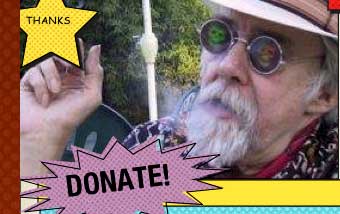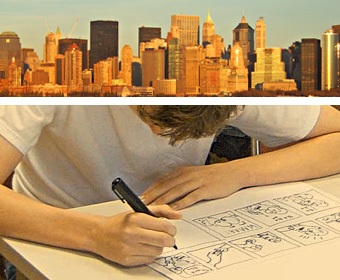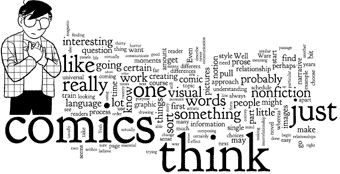 It’s all here. Help out one comics’ greats any way you can.
It’s all here. Help out one comics’ greats any way you can.
Also going the distance is David Chelsea who’ll be dedicating his next 24-hour comic event to raising money for Wilson.
 It’s all here. Help out one comics’ greats any way you can.
It’s all here. Help out one comics’ greats any way you can.
Also going the distance is David Chelsea who’ll be dedicating his next 24-hour comic event to raising money for Wilson.
 Hope you’ll join me for my two-day making comics seminar in Manhattan, courtesy of the MFA in Interaction Design Program at the School of Visual Arts and IxDA NYC. Details here.
Hope you’ll join me for my two-day making comics seminar in Manhattan, courtesy of the MFA in Interaction Design Program at the School of Visual Arts and IxDA NYC. Details here.
In reference to our earlier thread on formats, I think for those who choose a screen-fitting page-to-page approach, the format SMASH uses is one of the better ways to go.
Designed for photo slideshows, I assume (at least that’s where I usually see it) but a nice fit for long-form comics.
[Update: They’re using Lightbox 2. See comments.]
 And the first one to get that reference wins second-biggest nerd prize.
And the first one to get that reference wins second-biggest nerd prize.
Don’t know if you’d glanced at the right sidebar, but we now have a proper feed, as well as (thanks to Lori) a syndicated livejournal feed.
Met an old friend of the family (and her own wonderful family) at Vassar last month who called me “Scotty.” I realized that my older sister Ruth was the only one who ever called me that. (Diana, the FOTF, was about my sister’s age).
We did have a “Scotty” (Scottish Terrier) named “Maddy” for years though, sadly no longer with us. Preceded the naming of Neil’s youngest, though no cause-and-effect should be inferred.
Random thoughts, spurred by yesterday’s inbox, and an adorable bit of art from Becky at Tiny Kitten Teeth.
The New England Webcomics Weekend (remember?) was a big hit and newsworthy in and of itself, but of special interest to the mad scientist set (okay, me) was their “Infinite Canvas Room”—a big room of blank walls anyone could add post-it panels to. This was the same method that produced Merlin’s groundbreaking PoCom-UK-001 at London’s Institute for Contemporary Arts in 2003. No Merlin around to adapt this one, but fortunately we have this video walkthrough to commemorate it.
“…Goldman started with a definition of what comics are: stories told with words and pictures”
[SXSW “Comics on Handhelds” panel – link via James Burns]
Dan Goldman is, I’m sure, using the above in the spirit of opening minds to comics’ range and flexibility. But under the image of the Watchmen “motion comic” it offers a grim reminder of how our conception of comics now can point us down some dark roads in the near future.
I don’t doubt that a lot of hard work and earnest creativity went into the building of the WMC, but if the future of comics is cheap pseudomovies on cell phones, you can count me out.
 Recent interview by Scot Hanson, boxed up and linked à la my old trails webcomics. Scot asked good questions, so I did my best to give him good answers—or will (it’s dated November 2009 at the top).
Recent interview by Scot Hanson, boxed up and linked à la my old trails webcomics. Scot asked good questions, so I did my best to give him good answers—or will (it’s dated November 2009 at the top).
Also online this week is an old interview from the family’s visit to University of Virginia during the 50 State Tour in 2007. Go here to download Issue #3 of the student-run Pulse Comic Zine for my interview.
Hey, great discussion on yesterday’s post, Everybody. Thanks!
Cartoonists are always finding ways to balance their pages. We can’t help it. If there’s a close-up in the lower left, we balance it a little on the upper right. If there are a lot of spot blacks on one page, we find more spots on the other. We’re taught that dynamic balance is more interesting than static balance, but the goal of balance itself remains. Balance can lead to harmonious, satisfying compositions, but is that what comics artists really want? A satisfying page is a page you can stay on, linger on, stop on—a page without momentum.
When we walk, all we’re doing is falling. We fall a little, stop ourselves from falling, then fall a little more. Balance keeps us from falling on our faces, but it’s imbalance that gets us where we’re going.
I wonder: Would it help to forget panel 1 when I draw panel 2, and forget 2 when I draw 3? The result might be an imbalanced mess, but would it also be a more interesting mess? A more surprising, less typical, mess? Would it lead the reader to wonder what the next spread had in store, and feel less confident he/she could predict the shape of each one?
Imbalance already drives stories forward—a character lacks something, the world’s out of joint, trouble’s on the rise—maybe it should also play a more prominent role in storytelling.